Swaminarayan Akshardhaam
Although it has been a zillion times when i have crossed ‘Akshardhaam Temple‘ in my car, passing a fleeting glance towards it, this is the first time I am here as someone genuinely interested in it. It is early morning and Swaminarayan Akshardhaam temple, which is built on the banks of river ‘Yamuna‘ is lit up golden with sun’s rays.
I am aware that photography is strictly forbidden within the temple premises, which is a pity; I take my first photographs from the Akshardhaam metro station. The temple showcases Indian art, wisdom, heritage and values and is a torchbearer of Indian culture. Akshardhaam, build in duration of 5 years as a tribute to ‘Bhagwan (Lord) Swaminarayan‘ radiates peace, joy and divinity.
It is a ten minute walk from the metro station towards the temple entrance. En route, I find numerous hawkers selling green coconuts, ‘Jaljeera‘ (an Indian green drink made of mint leaves), ‘Bhel Puri‘ (a spicy Indian snack originating from the Indian state of Maharashtra)
A sip of coconut water in scorching Indian summer can keep you going for hours feeling refreshed and bouncy. The ‘Jaljeera‘ seller is ecstatic to have his photograph clicked. I am sure he has not been happier during the day. He offers me a glass full but I politely decline fearing any unwelcome infection.
I go through multiple layers of high profile security at the temple entrance. Along with any photo shooting device, leather goods like bags, belts and wallets are also not allowed inside the temple. I see tourists from various regions of India and across the world. Along with native Indian languages there are guide books available for tourists in English, German, Italian, Spanish and Dutch.
Tourists are welcome by an arena of ten gates, intricately carved out of red stone. The Ten Gates reflect the Vedic sentiment of inviting goodness from everywhere to all visitors. This is followed by ‘Bhakti Dwar‘ (Gate of Devotion), which offers devotion to God and his choicest Devotee in the genuine form of worship. This gate is smeared with 208 sculpted forms of God and his devotee. Following this, is the ‘Mayur Dwar‘ (Peacock Gates), which adorn 869 sculpted figures of the Peacock, the national bird of India. I wish I could click photographs of these gates and of myself with my eyes popping out in amazement.
Right after the ‘Mayur Dwar‘, are the holy footprints of ‘Bhagwan Swaminarayan‘. They are carved out of white marble and bear 16 sacred signs of God. Water is continuously showered on them from four Conch shells. I stop to take some notes but to my annoyance, a guard comes running to stop me from doing that. With gritting teeth and a guilty smile on my face, I keep my notebook back inside my pocket. However, within moments I am again carried away into a space of awe as I move ahead towards the main temple complex.
The vortex of the whole complex is the grand Akshardhaam monument, carved out of pink stone and white marble. It is built without the use of steel and contains 234 intricately carved pillars, 9 magnificent domes and over 20,000 carved figures. Seated in the centre of this monument is the 11 ft. high gold plated ‘murti’ (statue) of ‘Bhagwan Swaminarayan’. I can’t believe my eyes as I see the staircase to this ‘murti’, which is made out ‘slabs’ of precious stones. There is a lot of pushing and pulling happening as people behind me crane their necks to get a glimpse of what I am seeing, but I stand my ground hypnotized for a long time determined not to let the people behind me steal my moment of joy.
The whole monument rests on 148 life size elephants carved out of pink stone and dozens of other sculptures of people, animals and birds. I read the description in front of each of the carved elephants and find that they are a tribute to the glory of elephants in Indian culture.
The complex also houses various exhibition shows, light and sound shows depicting the richness of timeless Indian history. I wanted to experience the 14 minute boat ride through 10,000 years of Indian culture but the queue was too long. On the boat ride, one can witness life size models of world’s oldest Vedic villages and bazaars, sail through ‘Takshashila’, world’s oldest university and learn about the discoveries and inventions of scientists from ancient India.
It is lunch time and I walk into the temple’s own food complex. I have been to many food courts and restaurants around Delhi who claim to sell high quality authentic Indian food but after seeing the preparations here I can safely say that none of those restaurants are true to their word. The whole space is filled with the aroma of dishes being prepared in ‘Ghee’ (Clarified Butter) which has been used in Indian cooking much before ‘cooking oil’ came into existence. The last course in an Indian meal has always got to be something sweet. The extensive collection of Indian sweets makes me want to have all of them even though I am constantly aware of the growing size of my overfull tummy.
With sleepy eyes but headstrong on exploring more amazing temples of Delhi I head towards ‘Chandni Chowk‘ in old Delhi. I only wish I had more of photographs of ‘The Akshardhaam Temple‘ to show here. ‘Magnificent‘ will be a naive word to use for this piece of architecture.
Sri Digamber ‘Lal’ (Red) Jain Temple
Next stop in my journey is the ‘Sri Digamber Jain Lal Mandir‘ (Sri Digamber Jain Red Temple). It is situated in the heart of Old Delhi, ‘Chandni Chowk‘ (Moonlit Square). Incidentally, ‘Chandni Chowk‘, although one of the oldest regions of Delhi, is well connected by The Delhi Metro. I get down at the Metro station and find my way through the maze of narrow streets where everything seems to be precariously balanced. You will find the best clothes, food, electronics and jewellery in this market but you got to have an eye for the original, otherwise you will easilly end up buying some phoney stuff. There is a lot of similarity between the narrow streets & shops of Chandni Chowk and those of the Grand Bazaar of Istanbul with the former being much bigger in size.
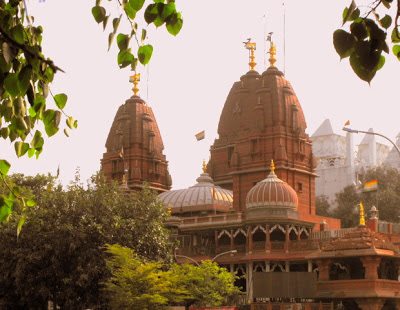
‘Sri Digamber Jain Lal Mandir‘ is situated right in front of the massive ‘Red Fort‘. This temple, made of Red Sandstone was built during the reign of Mughal emperor, ‘Shah Jahan‘ in 1656 AD. To my dissapointment, photography is prohibited here as well. With irritations reaching newer levels, I keep the camera back in my bag. However, the smiling face of a girl selling local spices on roadside lifts up my spirits once again. The girl’s father is happy to have his daughter’s photograph clicked by someone through whom she may get to be in media someday. Before I could take a snap, he asks me, ‘Are you a Journalist?‘ I politely say, ‘No, i am a traveler‘. Upon seeing the dwindling opportunity of being in media, the girl settles for some money in lieu of allowing me to take her photograph. With a little chuckle on seeing the girl’s innocence, I buy some cardomom pods in exchange of the money, take the photograph and move on.
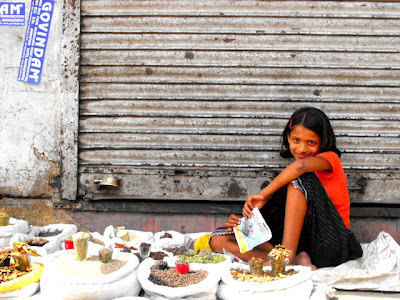
I have reached pretty early and have to wait for an hour as it’s lunch time for the priests and the temple is closed. Finally, after an hour of chatting with the guy collecting shoes of visitors, the gates open. I remove my shoes and walk in (Wearing shoes inside a religious place is forbidden in Indian culture). The marble flooring is much cooler as compared to the heat outside and it’s blis to walk barefoot on it. The complex is regularly washed to maintain cleanliness.
Although ‘Jainism’ originates from India, has numerous followers and I have read about it since childhood; it was my first visit to a Jain temple in all these years of my life. The main shrine of this temple, dedicated to ‘Lord Mahavira’ (the founder of Jainism) is truly magnificent. The walls and roof are decorated with very fine enamel work which is shining under the lights of butter lamps and candles. I am disappointed to see that lack of proper maintenance has caused some damage to the fine enamel work but attempts to collect donations and restore it are underway. This temple is very popular among people of all faith, especially Jain. Devotees regularly visit with offerings such as Rice, Grain, Fruit and Candles.

The complex also houses a library on Jain literature and a charity hospital for birds. The hospital is dedicated to Lord Mahavira’s message of – ‘Live and Let Live‘. I have spent over an hour here and now it’s time for me to explore the neighbouring ‘Gauri Shankar Temple‘.
Gauri Shankar Temple
‘Gauri Shankar Mandir‘ (Gauri Shankar Temple) is situated right next to the Digamber Jain Temple in Chandni Chowk. Made of white marble, this temple is dedicated to ‘Lord Shiva‘ (the destroyer or the dissolving force in life) and ‘Parvati‘ (complete incarnation of the original creator, preserver and destroyer of the whole universe). The sect of Hinduism dedicated to the worship of Lord Shiva is called ‘Shaivism‘.
This 800 year old temple stands amidst the mixed fragrance of numerous flowers displayed for sale in the nearby flower shops. One of the most important temples of ‘Shaivism’, it has an 800-year-old brown ‘lingam’ (phallus stone) encased in a marble representation of a female organ. Surrounded by snakes made of silver, the lingam according to Hinduism represents a ‘cosmic pillar, the center of universe, the life itself’.
A legend is that one-day, Mughal Emperor Aurangzeb ordered that the temple bells would not be rung. For the next three days, he kept hearing the ringing of the bells in his ears. Finally, he gave up and took back his orders.
This temple may be far smaller as compared to the ‘Swaminarayan Akshardham’, but its age old history and the faith of people makes this place worth a visit. I choose to just sit on the marble stairs and watch the devotees. I find very intriguing the tradition of folding ones hands, kneeling down and rubbing ones nose on the steps of the main shrine before entering it.
Devotees make offerings of ‘Bilva‘ (wood apple), ‘Chandan‘ (sandal wood paste), marigolds, red powder, rice and ‘Kelava‘ (Cotton threads). There are couple of vendors selling packages of these offerings giving the surroundings a colourful look. When I ask them for a photograph, they readily give their best pose, sans a smile.
Inside the temple I am amazed to see an approximately 20 ft. tall statue of Lord Shiva with arms wide open as if calling on the energies of this universe. It is kept behind a glass case. Outside the glass case on one of the walls is the ‘Trishula’ (Indian trident) which is a weapon of Lord Shiva. Along with the ‘Trishula’ is the huge bronze idol of ‘Nandi’ (the bull which serves as the gatekeeper of Shiva and Parvati)
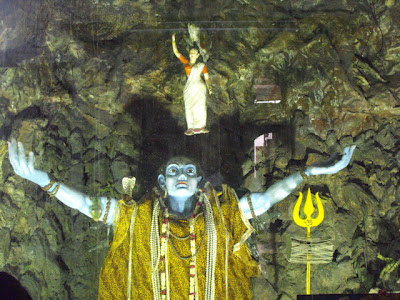
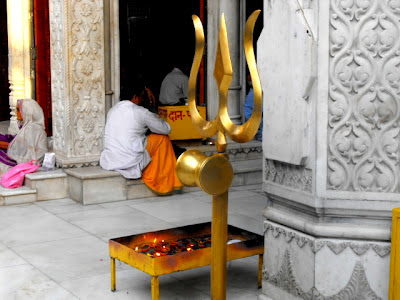
Sitting there, I observe people willingly give some money and ‘Prasad‘ (edible food considered to have the deity’s blessings residing within it) to an old lady who, in turn, is giving her blessings to them. She must have spent quite a lot of time of her life here because almost everyone seems to know her. I also approach her, give her some money, and touch her feet to seek blessings. To my surprise, she squeals with happinessl a squeal which I did not hear from her in the last half an hour while many people came and went. She keeps her hand on my head to bless me. The warmth and love in her voice and actions fill my heart with joy and some surprising emotions..
It’s dusk now and I am heading back home having completed the first leg of my temple explorations. I am closer to my own culture; know much more about it and eager to start the next phase.
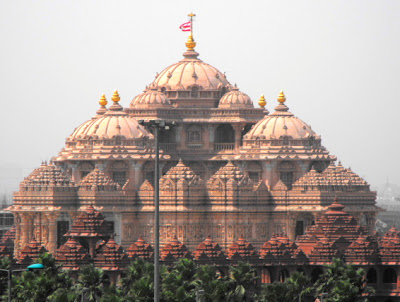
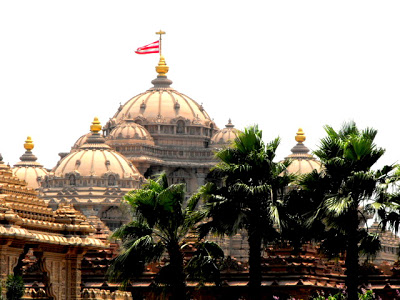


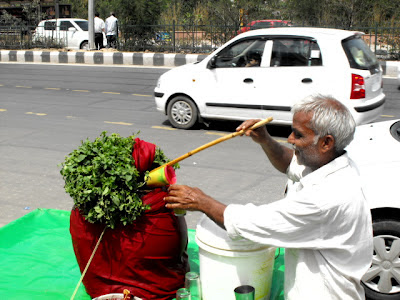
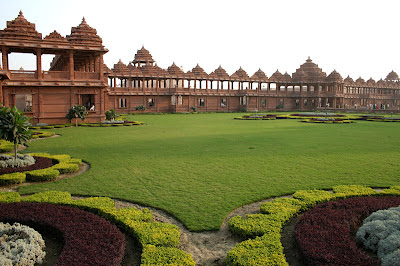
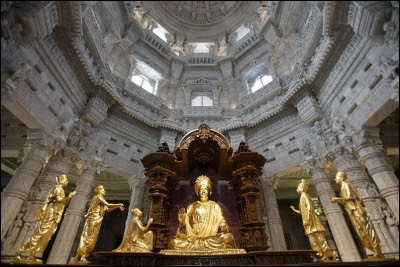
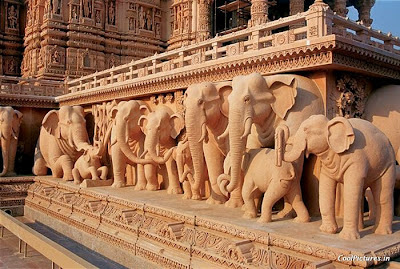
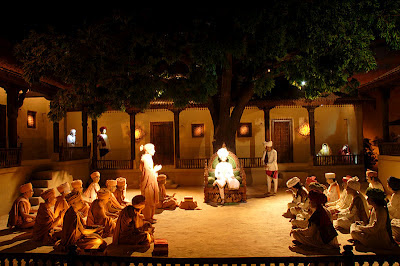



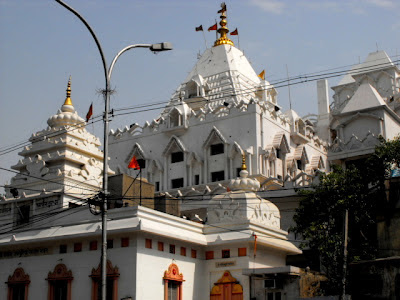
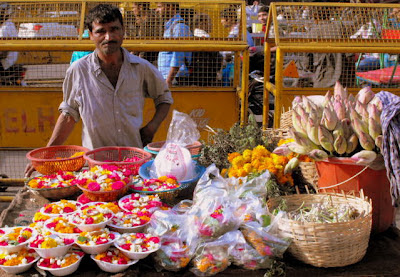


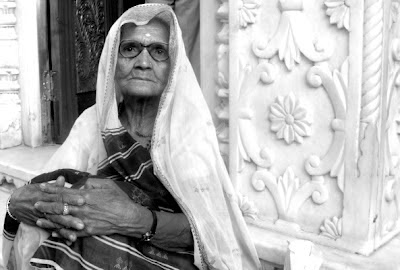
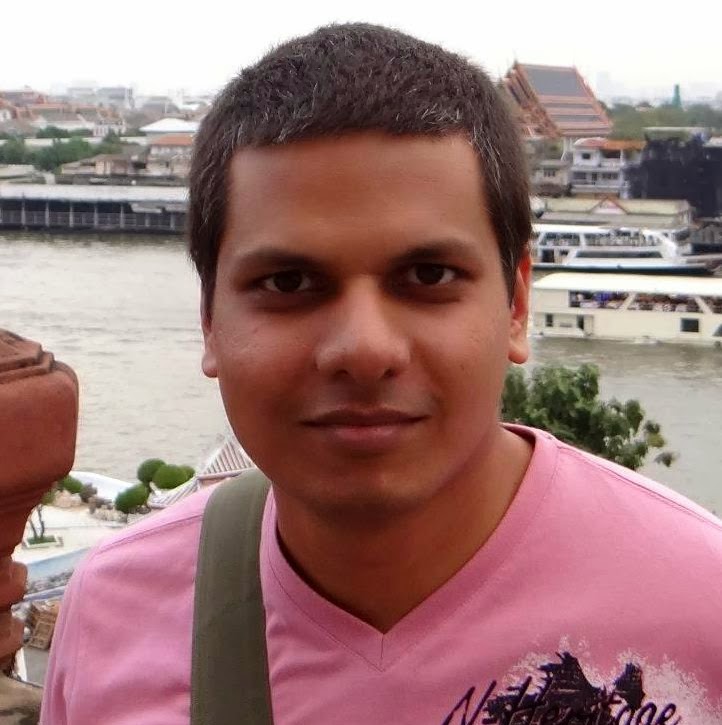







stunning pictures and brief interesting write up …
Hi, thanks a lot for your nice words. I am glad you stopped over and liked it.
Gaurav
I certainly feel the passion you have for travelling and visiting such invaluable pieces of art and culture…well done!
Love your posts on the temples around Delhi! Really looking forward to exploring the homeland and culture of many Canadian immigrants.
Jason. I am happy that you liked the story. You are welcome to India. If you need any info just ask !! 🙂
I saw your website. The presentation is so welcoming. Will definitely go back to explore more of it.
Thanks for updating
more information. Similarly you can also get more information about the top 15
places to see in delhi by visiting this site.
places to see in Delhi
hello……… thank u for your information about indian
it very beautiful………